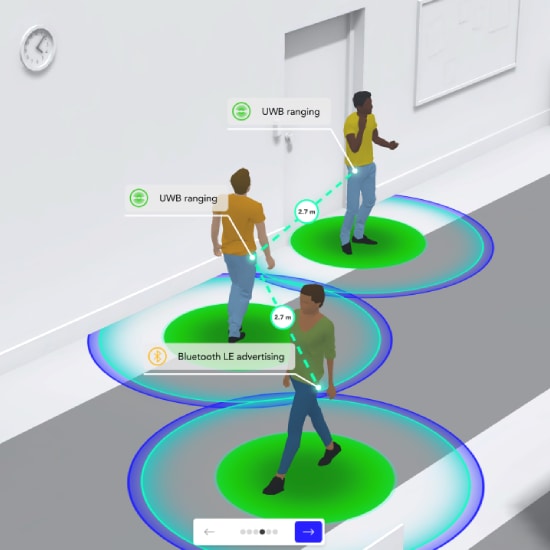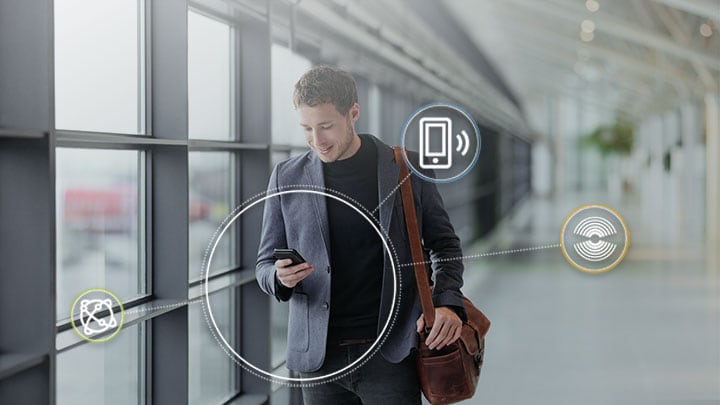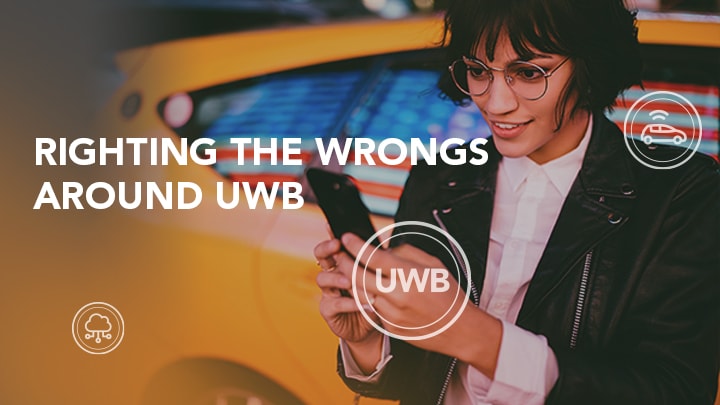To help slow the spread of the virus that causes Covid-19, the World Health Organization (WHO) recommends that people maintain at least a 1-meter distance from one another. Social distancing, or physical distancing, as it’s also called, limits exposure and reduces the risk of infection, but it can be hard to know, without using a measuring tape or some other physical indicator, exactly how far away you are from someone.
It’s especially easy to let your guard down when you’re in familiar surroundings, with familiar people, as happens in the workplace and in classrooms. Interacting with people you know can create a false sense of security, and focusing on a task can divert your attention away from the act of maintaining a safe distance. But technology can help.
A purpose-built device that you wear around your neck, place on your wrist, pin to your shirt or put in your pocket, can help determine how far you are from someone else and alert you when you’re too close. Should someone else, wearing a similar device, come inside your pre-determined safe-distance “bubble,” an alarm signal, either audible, vibrating, or both, alerts you of the need to step back.
How Close Is Too Close?
Using a device to measure and maintain distance takes the guesswork out of staying safe. You don’t have to be an expert in virus transmission, or make a judgement call on how far away you are, to reduce your risk of infection. Also, you can stop being your own personal enforcer, telling people to move away, because the technology does it for you. It’s like having an impartial expert continuously monitoring your environment, to make sure everyone stays safe.
The technology used in social-distancing devices can help reduce viral transmission and as a result help restart the economy by making it safer for people to return to the workplace, get back to in-person learning and start using public spaces again.
UWB for Precision and Reliability
Ultra-wideband (UWB) technology, which is a wireless technology recognized for its use in high-accuracy localization applications, is an excellent choice for social distancing. Running on a rechargeable or coin-cell battery, a social-distancing device based on UWB can provide distance measurements with unmatched accuracy of +/- 10 cm.
A sample design for a UWB-enabled social-distancing device combines Bluetooth low energy (BLE) scanning, to identify the presence of other devices, with UWB for precise measurements. The following images show how this works. The BLE function continually scans (or advertises) for other devices. When the BLE function detects the presence of a similar device within a given distance (six meters, for example), it wakes up the UWB function to begin ranging.
The UWB function monitors the location of nearby tags, with the ability to track multiple tags at once, so several people can be in a given space and use their devices to maintain distance. If the social-distancing limit is breached, the device alerts the wearer and can also make a record of the encounter and its duration, to support contact tracing if the wearer later tests positive for Covid-19.

A Private, Standalone Solution
As long as everyone in the space is carrying or wearing a UWB-enabled device, no other hardware is needed to support social distancing. The UWB function can use peer-to-peer operation, which means there is no additional infrastructure required for operation.
Also, to ensure privacy, the social-distancing device can be designed to comply with guidelines of the EU’s General Data Protection Regulation (GDPR). That is, the device can be configured to provide its warning based on distance alone, not identity, and need not record personal data. The administrators who issue social-distancing devices can record who wore which device, so if symptoms are later reported, the administrator can identify who wore which tag and generate a list of people at risk.

Contact Tracing with Bluetooth Alone May Not Be Enough
Bluetooth on its own can be used for social distancing (and is the basis for a number of smartphone apps used for contact tracing) but the measurements provided by Bluetooth alone are not as accurate as those provided by UWB.
Bluetooth uses a technique, called received signal strength indicator (RSSI), to estimate distance. The stronger the signal, the closer the object is deemed to be. But there are a number of factors that can influence signal strength and, as a result, reduce accuracy in contact-tracing apps that rely on Bluetooth for readings. If, for example, the smartphone is hidden away in a bag, or the signal has to pass through a human body to reach the other phone, readings may not indicate when someone is too close. The same is true if two people are working side by side or if one is behind the other. Also, outdoor readings are often more accurate than those made indoors. By contrast, the presence of metal objects (as when riding on a train or walking down a supermarket aisle), can boost signals, making it appear that someone is actually closer than they are.
Adding UWB Delivers the Required Accuracy
Compared to Bluetooth, UWB is more robust and maintains a higher degree of accuracy (± 10 cm), even in difficult operating conditions. The UWB pulse signal works without line of sight, in all directions, and shows greater immunity to commonly encountered situations that can interfere with other wireless technologies used for distance, including the multipath effect.
UWB enhances location by delivering more precise readings than any other technology currently in use. UWB co-exists with today’s most popular wireless formats, including Bluetooth, and can make devices and apps used for social distancing and contact tracing that much more accurate and reliable.
As the Covid-19 pandemic continues to change day-to-day habits, UWB can help us regain a degree of normalcy and bring people together again while reminding us of what’s really important: our personal safety.
The NXP Approach to UWB
Offering one of the broadest UWB portfolios to market, NXP provides everything needed to create a UWB-enabled device for social distancing:
- Trimension SR040, optimized for IoT trackers, for remarkably precise positioning performance to coin-cell battery-powered UWB trackers
- Bluetooth LE solutions to achieve ultra-low power consumption when UWB ranging is not needed, so as to extend battery life
- Motion sensors, based on MEMS accelerometer technology, with low-power wake feature
Learn More
To learn more about how UWB can enhance efforts to maintain social distancing and make it safer for people to share indoor and outdoor spaces, visit Ultra-Wideband.






